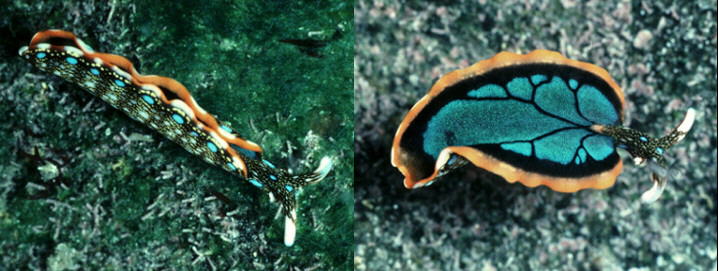 |
Thuridilla splendens
Lizard Island, AustraliaPhotos courtesy of Jeff Hamann and Jim Lance
Thuridilla splendens , Baba, 1949
When Jim Lance presented the above photos at a recent WSM conference, I marveled at the intense metallic blue color the animal displayed with the parapodia unfurled. Upon reflecting on the total body coloration of Thuridilla splendens, it occurred to me that , HEY, wait a second! This animal is in the Sacoglossa order! What's with the color and why are they often seen crawling out in the open away from the usual algal prey most Saco's seem to associate themselves with ? Cimino and Ghiselin postulate that the color adaptation has enabled Thuridilla to move from a more traditional cryptic setting of larger algal masses to smaller patches protected by defensive chemicals derived from their food. It has been my experience in the Indo-Pacific to see Thuridilla roaming about much in the manner of some highly decorated chromadorids.
According to Gosliner, T. splendens is found only in the western pacific and can be differentiated from T. bayeri by the presence of yellow spots on the sides of the parapodia and foot which are absent on T. bayeri . See also T. splendens on Bob Bolland's Okinawian Slug Site and also Bill Rudman's Sea Slug Fourm.
Well, what about the colbalt blue color displayed when the parapodia are opened? One local brancher here has speculated that it is a physical color (schemocrome) as the result of colorless body structures. Schemocromatic color is the result of submicroscopic ridges, striations, etc. which break up light rays into component colors. If this is true, does this same theory also apply to other areas of the body where this same intense blue is seen? This kind of coloration is in contrast to chemical natural pigments called biochromes which can be isolated from the animal.
I don't know what the real answer (schemocromatic vs. biocromatic) is, but it sure sounds like an interesting project for a grad student with a little time on their hands! Is there such a student?
San Diego, Calif
Aug. 2001
Camino, G. and Ghiselin, M. (1998) Chemical defense and evolution in the Sacogolossa (Mollusca: Gastropoda: Opisthobranchia. Chemoecology, 8:51-60
Gosliner, T.M. (1995) The genus Thuridilla (Opisthobranchia: Elysiidae) from the tropical Indo-Pacific, with a revision of their phylogeny and systematics of the Elysiidae. Proceedings of the California Academy of Sciences, 49(1): 1-54.
